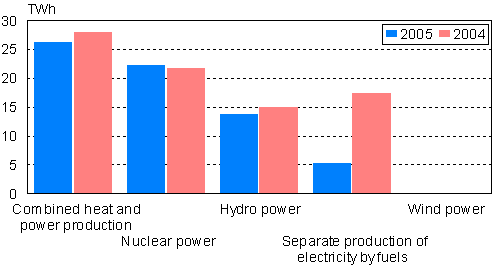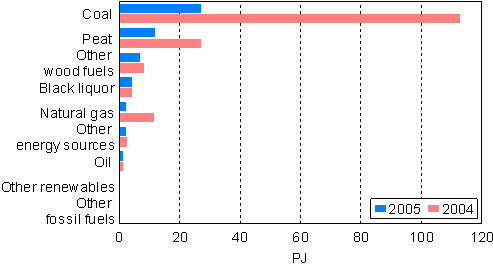Production of electricity and heat in 2004 and 2005
According to Statistics Finland's statistics on production of electricity and heat, electricity produced in Finland amounted to 67.8 terawatt hours (TWh) or 67.8 billion kilowatt hours (kWh) in 2005. The volume of electricity produced was 17 per cent lower than one year previously. District heat production totalled 32.6 TWh, which was slightly more than one per cent down from the year before, and industrial heat production was 58.1 TWh, which was seven per cent down from the year before.
The decreases in the production volumes of electricity and heat were due mainly to the increased imports of electricity, warmer weather than in the previous year and the industrial action in the forest industry.
Production of electricity and heat by production mode in 2005
| Electricity | District heat | Industrial heat | Total energy used1) | ||
| TWh | TWh | TWh | PJ | ||
| Separate production of electricity | |||||
| Hydro power | 13.6 | - | - | 48.9 | |
| Nuclear power | 22.4 | - | - | 243.9 | |
| Wind power | 0.2 | - | - | 0.6 | |
| Separate production of electricity by fuels | 5.3 | - | - | 58.0 | |
| Total | 41.4 | - | - | 351.5 | |
| Combined heat and power production | 26.4 | 25.3 | 44.2 | 427.6 | |
| Separate production of heat | - | 7.3 | 13.9 | 87.9 | |
| Total | 67.8 | 32.6 | 58.1 | 867.0 | |
1) Total energy used refers to the
amounts of fuels used.
Hydro power and wind power were made commensurate with fuels
according to directly obtained electricity (3.6 PJ/TWh) and nuclear
energy at the efficiency ratio of 33 per cent from produced nuclear
power (10.91 TJ/GWh).
Electricity production by production mode 2005

Electricity production by production mode 2004 and 2005

The production of nuclear power grew somewhat. Thirty-three per cent of electricity was produced by nuclear power in 2005. Twenty per cent of electricity was produced by hydro power, and the proportion of wind power, which was rounded up to 0.2 TWh, grew to 0.3 per cent. Combined heat and power production accounted for 39 per cent of the electricity produced.
Separate production of electricity by fuels plummeted to less than one-third of the volume produced in 2004. This decrease was compensated for with imported electricity from Sweden and Russia.
The use of fuels in production of electricity and heat decreased by 20 per cent. The use of fuels in combined heat and power production fell by 7 per cent and in separate production of electricity by as much as 66 per cent. The use of fuels in separate production of heat increased by 2 per cent.
Black liquor from the forest industry became the biggest and natural gas the second biggest fuel in production of electricity and heat, as the use of coal fell to less than one-half of the volume used in 2004. Use of coal decreased in all other forms of energy production except separate production of heat. The decrease was the most dramatic in separate production of electricity. The proportion of black liquor and other concentrated liquor of all fuels used in production of electricity and heat rose to 23 per cent, even though the industrial action in the forest industry cut its volume by 11 per cent from the year before. The proportion of natural gas stood at 22 per cent, and that of coal and other wood fuels at 15 per cent of the fuels used. The proportion of peat remained at 12 per cent, even though its use decreased by 23 per cent.
Use of fuels in production of electricity and heat 2004 and 2005

The large decline in separate production of electricity caused a decrease in the use of fuels. The use of natural gas decreased the most, by 82 per cent, even if natural gas is used rather little in separate production of electricity. The use of coal fell to roughly one-fourth of the volume used in 2004, but it still remained the biggest fuel in the separate production of electricity.
Use of fuels in separate production of electricity 2004 and 2005

The use of nearly all fuels fell slightly in combined heat and power production. Because of the own energy production of the forest industry, black liquor remains the biggest fuel in combined production. The proportion of black liquor of fuels used is 30 per cent.
Use of fuels in combined heat and power production 2004 and 2005

There were no major changes in the use of fuels in separate production of heat, where oil remained the biggest fuel. Its proportion of fuels used in separate production of heat was 33 per cent.
Use of fuels in separate production of heat 2004 and 2005

Last updated 27.12.2006
Statistics:
Production of electricity and heat [e-publication].
ISSN=1798-5099. 2005,
Production of electricity and heat in 2004 and 2005
. Helsinki: Statistics Finland [referred: 20.4.2025].
Access method: http://stat.fi/til/salatuo/2005/salatuo_2005_2006-12-28_kat_001_en.html

